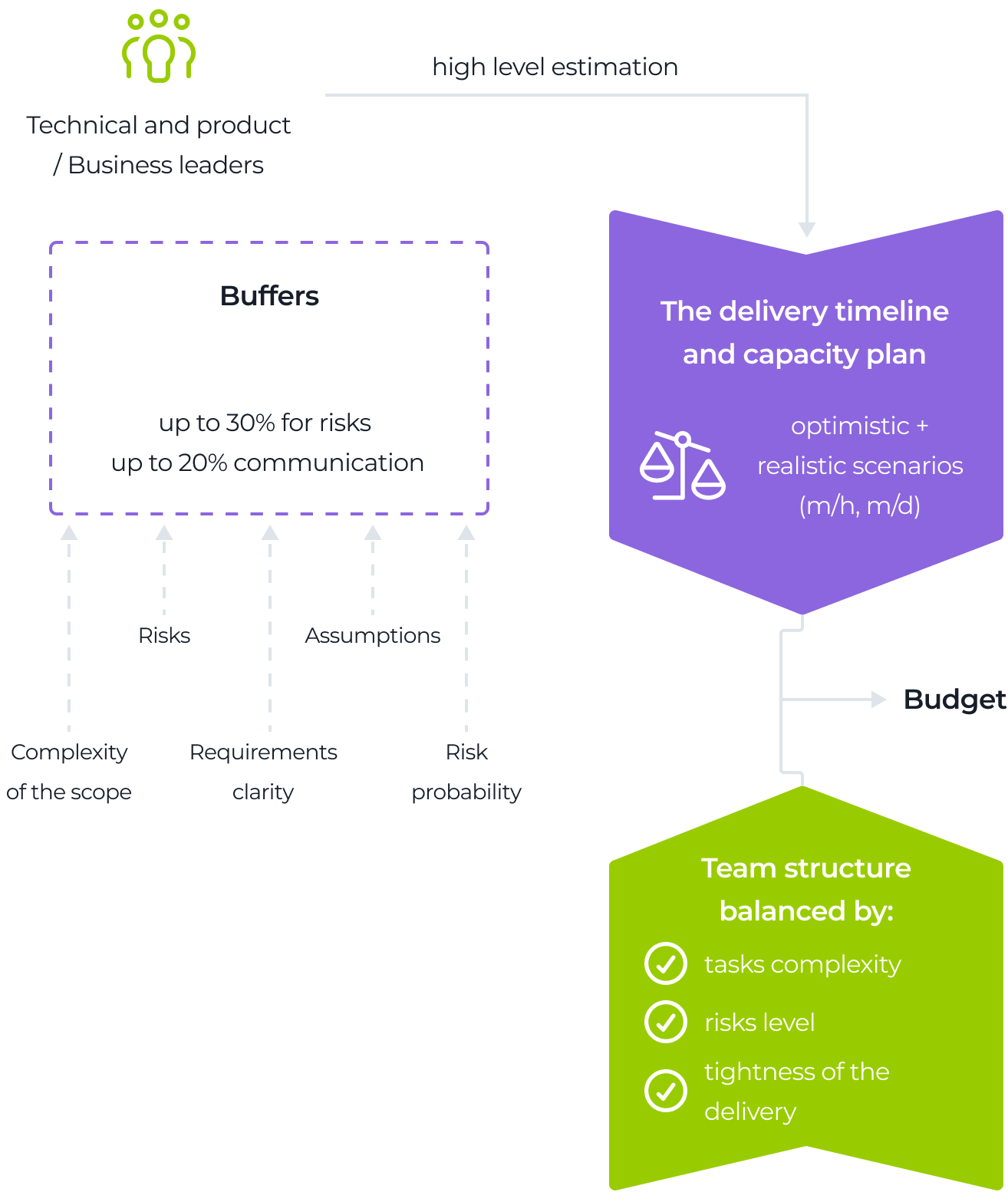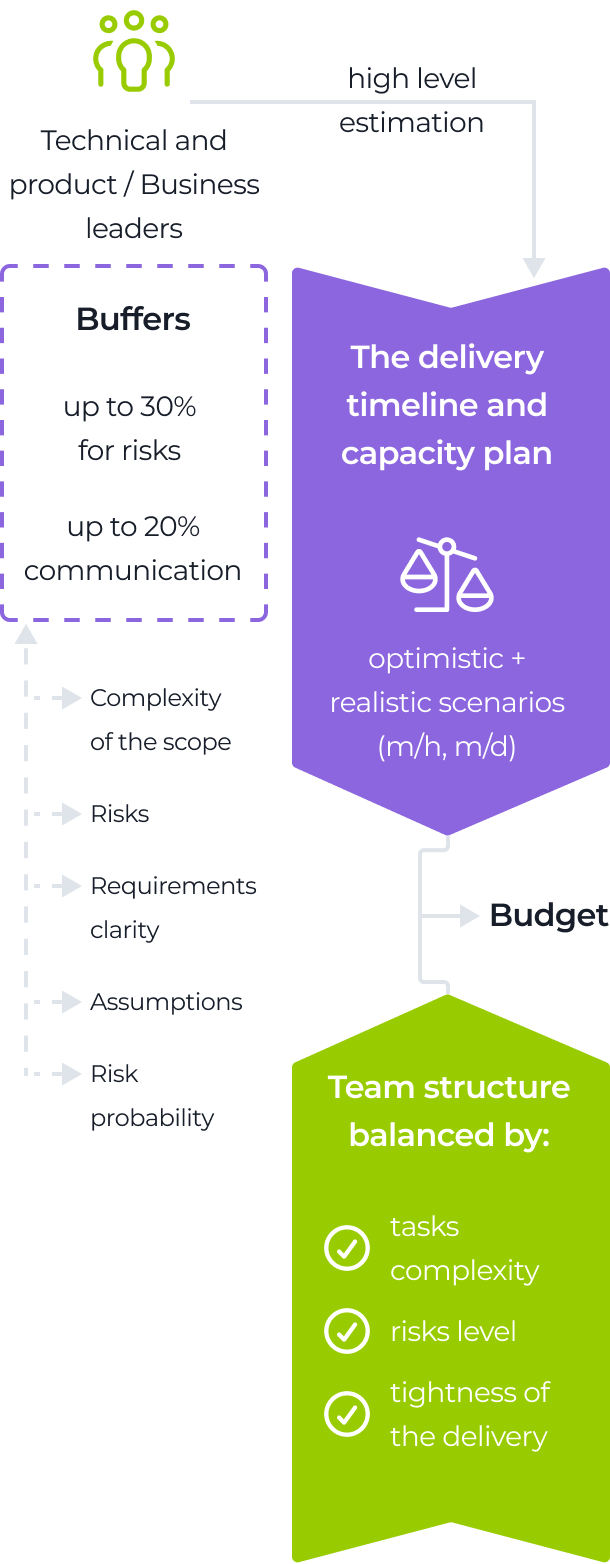When you need to scale your digital capabilities, but staff augmentation just piles on management overhead… When your product’s roadmap is constantly evolving, but a fixed-scope approach is too rigid to evolve with it… There’s a better way. Our managed capacity model gives you a dedicated, right-sized product team that flexes with your priorities. We take full ownership of delivery, staffing, risks, and KPIs, while the driver’s seat is yours.
Home Managed Capacity
An alternative to traditional outsourcing models that thrive on cost-cutting, narrow scopes, and standardized contracts, managed capacity services redirect the focus toward strategic impact and measurable project outcomes. The name says it all: managed means we own delivery end-to-end, spanning recruiting, mentoring, running the team, and take accountability for KPIs and operational risks. Capacity means you get elastic, cross-functional skills within pods of 3-8 experts that can be adjusted to your business needs on as-needed basis.
The entire managed team comes under one contracted monthly fee with no per head, per feature, or per hour charges. Costs stay predictable and you get the freedom to adapt the project scope on the fly without contract rewrites.
Managed capacity providers like *instinctools offer an ultimate blend
of specialized skills and operational efficiency. You decide on the ‘what’. We guarantee the ‘how’.


The problem with traditional models is that they often create complexity trying to suppress change. That’s the danger of over-control. Managed capacity normalizes adaptation by absorbing volatility, not resisting it.

01
02
03
04
05

Leaders opt for this engagement model if the stakes are too high for half measures and “good enough” or “we’ll figure it out later” can’t be a strategy. They know the benefits of a model that aligns with company culture, strengthens core competencies, and meets business needs more effectively than piecemeal external hires.

The expectations for the quality of the initial product were very high. I think *instinctools did a great job ensuring those expectations are met. We met the developers we were going to be working with and it quickly became apparent that they are very qualified and were able to deliver the vision that we had from our side for the product. They clearly told us what they were going to do, and if there were questions or problems along the way, they clarified them really quickly thanks to transparent communication.

We had a tight delivery deadline and *instinctools has been able to find another developer and assign him to our project from one day to another. And we’ve been able to successfully deliver this project. When the partner is good, things are just getting done. And that was the case with *instinctools.

The quality has been good. It’s been on the expected level: things come on time, we have a good visibility on the things that *instinctools developers are doing and performing for us, communication is good. Wherever we see that we need some more exra resources, we have found *instinctools to be a good partner in helping us out on those areas.

I’ve been impressed by the available skillset, the flexibility to ramp up resources quickly, and the scalability to extend development teams on short notice. I look forward to continue collaboration with *instinctools and their contribution to our projects.

People at *instinctools are quite tech heads, which I like. They have used very advanced libraries, advanced techniques, advanced coding paradigms. So the advantage is that we get reusable code, that we get well-testable code, we get well-maintained code.

The *instinctools team exhibits the flexibility and professionality required for young companies. You can rely on their tested structures and processes that integrate nicely with your internal workflows. Being able to grow your team quickly with experienced professionals that start delivering value immediately and without a long interview process is a huge help. And personally, you will be working with a team of kind and interesting people.

The team is dependable when it comes to managing time and finances, consistently staying within the designated budget. We’re pleased with *instinctools. Their business analysts are exceptional. They serve as the spokespeople between technology and business, representing both sides effectively.


Instinctools is good at understanding the technical issues – once an issue is outlined, they do not need repeated explanation. They also do not simply accept a proposed solution, but they think about it and propose a better solution. I was really impressed by the custom interface they built for us – we outlined the requirements, and they implemented them in a user-friendly way that makes the interface a pleasure to use.

Instinctools does deliver on time and budget. The company proactively asks how they can support our efforts and provide ideas how to help us with very good candidates with expertise that either we requested or that instinctools identified to be missing.

The team demonstrated effective project management, timely delivery, and responsiveness to our needs. They established open communication to facilitate ongoing dialogue and held regular sprint meetings to keep stakeholders informed and engaged throughout the development process.
We hate surprises. That’s why, we plan capacity with radical transparency through clearly defined timelines, realistic and optimistic scenarios, risk and communication buffers, and agile teams calibrated to the demands of each initiative.



Performance tends to run counter to big beautiful promises. Therefore, we anchor all accountability, scope, and guarantees in three foundational documents: the Master Services Agreement (MSA), Statement of Work (SOW), and Service Level Agreement (SLA).

The Master Services Agreement establishes our partnership framework through the definitive rules of *instinctools’ engagement. Designed in collaboration with your team, it maps out:
Operational framework: rotation procedures, support protocols, and escalation paths
Your Statement of Work sets the direction and outlines:
We co-author a Service Level Agreement with you, anchored in your objectives, operating environment, and definition of success. Here are some KPI examples, grouped by category:
Resource and planning
Service delivery
Financial
Engineering
Quality
As a trusted managed service provider, *instinctools assumes full responsibility for regulatory exposure, navigating stringent international and regional frameworks, from broad data governance regulations like GDPR and CCPA to industry-specific mandates like HIPAA and PCI DSS. We also stay ahead on emerging tech rules, such as the EU AI Act and NIST AI RMF, keeping your innovation both powerful and protected.
By embedding collaboration and enforcing non-negotiable quality metrics, we stop timelines from slipping and erase scope ambiguity. At the same time, we shield projects from resource gaps and communication breakdowns with dedicated capacity and clear escalation paths.
Backed by our very own experience-driven delivery framework built on transparency, proactive risk management, and regular stakeholder alignment, we ensure every software development project moves forward with clarity, full control, and confidence.
Not all external resources are created equal. Scale the way you need with staff augmentation, a dedicated team, or managed capacity.
| Capability / Artifact | Staff augmentation | Dedicated team | Managed capacity |
| Providing engineering capacity | |||
| Candidate selection for the project | Client | Client | |
| Onboarding and knowledge transfer | Client | Shared | Shared |
| Project documentation | Client | ||
| Software development process setup and maintenance | Client | ||
| Project, team, and risk management | Client | Shared | |
| Compliance and security | Client | Shared | |
| Quality and performance | Time reporting | A mix of delivery, productivity, and quality metrics for Agile / Scrum | Service Level Agreement (SLA) |
Managed capacity isn’t a one-size-fits-all solution. It’s a strategic choice for situations where outcomes matter more than output and where flexibility is non-negotiable. Not every project needs this. But yours might.

You’re shipping, learning, and course-correcting in real time. Priorities are rearranged mid-sprint because customer behavior or executive direction changes… again and again. Traditional, scope-bound contracts become a brake as every pivot triggers a new SOW, a negotiation, and, consequently, a delay. Managed capacity services let you steer the backlog without paperwork gymnastics. You keep a stable, cross-functional team pointed at outcomes, and you decide week to week whether to productionize a feature, retire it, or evaluate a new priority.
This is the product the company will be judged on. Revenue-critical. Board-visible. Unforgiving of rework. You can’t afford the quality debt that comes from short-term staff churn or fragmented vendors. Managed capacity buys continuity: the same engineers, designers, and QA live with the consequences of their decisions, sprint after sprint. They build observability in, own production incidents, and balance short-term execution against long-term product health, because for all practical purposes, they operate as your team.


AI safety reviews, platform migrations, complex DevOps, enterprise integrations are not skills you spin up overnight. You could spend quarters recruiting, onboarding, and training… or you can stand up a unit that already knows the territory and embeds with your product leaders. Managed capacity gives you specialists who can architect the path without committing you to permanent headcount before the business case is proven.
Long-term contractor engagements carry inherent legal risks, as many jurisdictions impose strict limits on the duration of independent contractor relationships. Exceeding these limits can trigger employee reclassification claims, back taxes, penalties, and legal complications. Instinctools serves as the formal employer of your dedicated team, ensuring all local labor, tax, and classification regulations are seamlessly met.

Instinctools offers a clear, four-step path from kickoff to consistent delivery, built to take ownership and show progress fast.
We review your BRD and business goals, assess SDLC readiness, surface gaps, and propose the initial delivery pod plus KPIs/SLAs for the SOW. Recommendations cover documentation, environments, pipelines, QA strategy, and reporting cadence.
Key specialists onboard first (for example, backend/frontend developers), followed by QA, DevOps, data, and others to keep throughput smooth. We align on repos, environments, releases, and support runbooks.
Shadowing (we observe and document how your product operates) → reverse shadowing (we run ‘safe firsts’ deployments, hotfixes, on-call, while the legacy vendor observes) → handover. Ownership shifts to our pod with stability checkpoints and defined fallbacks.
We own delivery against agreed KPIs, provide transparent reporting, and re-prioritize each sprint/PI to maximize impact.
Why AI projects derail and how we keep them on track
| Typical AI challenges | Our managed capacity response |
| Unclear objectives | Embedded tech leads who refine your hypotheses into an actionable AI roadmap |
| Talent scarcity | Flexible teams blending data scientists, AI engineers, MLOps specialists, and domain experts |
| Endless R&D cycles | An AI Delivery Manager runs cadence, risk/issue logs, and stakeholder reviews, ensuring you see transparent artifacts each sprint (backlog, experiment reports, model cards, data docs). |
| Production collapse/ Prototype hell | With MLOps and governance baked in from day one, we tackle the “never reaches production” problem |
| Budget blowouts | Predictable monthly investment aligned to capacity |
A managed capacity model gives you a team of cross-functional experts where the service provider takes full responsibility for delivery, KPIs, and project outcomes: you set priorities, we run the agile teams. In a staff augmentation model, you add external hires to your existing team and you manage daily tasks and performance by yourself.
Unlike a dedicated team setup, where you are involved in vetting and selecting individual candidates, the managed capacity approach only requires you to define the necessary roles. The provider then assumes full responsibility for assembling the right team and, crucially, contractually guarantees the quality of their output and performance through an SLA.
You get one contracted monthly fee for the whole managed team, which improves cost effectiveness and keeps the project budget predictable. The fee covers staffing, onboarding new team members, mentoring, ceremonies, project management, performance reviews, environments/tooling, and ongoing support – the services provided under agreed service levels in the MSA/SOW/SLA. Because it is capacity (not fixed scope) that is contracted, you can adapt project scope without contract churn while maintaining operational efficiency.
You retain full control over the “what” (backlog, priorities) while the managed capacity provider handles the “how,” including risk mitigation, continuity, and compliance. Governance sits in the MSA/SOW/SLA to ensure alignment and effective communication with direct access to software developers and leads. This model embeds specialized expertise (from core engineering to data analytics, domain expertise, and advanced technologies) alongside your in-house team, so you can easily scale capacity without the skill gaps and overhead typical of external staff.

